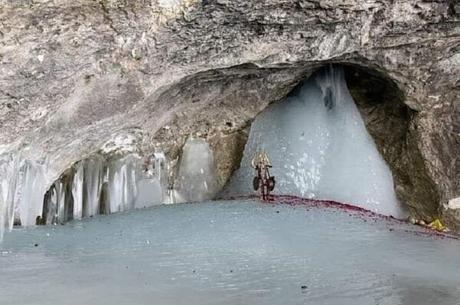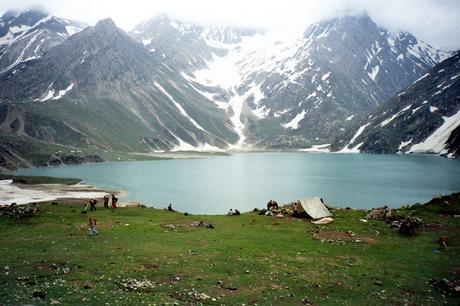Amarnath Temple: One of India’s four main pilgrimages, the Amarnath Yatra, draws throngs of followers who travel across the South Kashmir Himalayas to the Holy Cave Shrine of Shri Amarnathji each year. Only in the summer, from July to August, is the temple open to worshipers. People crowd around the ice statue of Lord Shiva that is shaped like a stalagmite called a Lingam.
The sight of the Moon causes an incredible waxing and waning of the image. Hindus in India view this Pilgrimage Tours as one of the most important responsibilities in their lives that can accurately point them in the direction of paradise.
The Amarnath temple is devoted to the worship of Lord Shiva and is one of the most sacred locations in India in the eyes of Hindus. It rises to a height of roughly 12,760 feet while go for Tours to Kashmir. Every year, devotees flock to the Amarnath Temple or Amarnath Cave to catch a holy sight of the Shiva Lingam, which is thought to have formed organically from ice.
When the ice Lingam is formed in the months of July to August, the temple is only open for a brief period of time each year. People start to believe in the sacredness of the location since the scene at the moment is so amazing. Water gently drips down into the cave from the top, freezes to form ice, forms a solid base, and then begins to take the shape of the Shiva lingam until it is fully formed on Purnima. Hindu scriptures claim that Lord Shiva revealed the meaning of existence to his devoted bride, Parvati. The temple’s history is a sacred one, and there is a lot more to learn about it.
Also Read: Information About Raghunath Temple
Significance Of Amarnath Temple or Cave

There is only one person, according to the Rigvedic verses, despite the fact that he goes by numerous names and is referred to by many great sages. There is a well-known verse in the Bible called “Ekam Sat,” which implies there is only one truth. The Parmeshwar is thought to have intervened in world affairs in three forms, known as the Holy Trinity. Shiva is regarded as the god who purifies good and destroys bad, according to the Rigveda. Astronomy, Vedic tales, and even some rituals have all attested to the existence of Lord Shiva as a living deity. Evidence from Mohenjo-Daro and Harappa confirms that Lord Shiva was a highly respected god in ancient India.
Lord Shiva is particularly identified with the Amarnath Temple or cave. In this cave, Shiva is claimed to have told his companion Parvati the tale of the universe’s creation and the key to eternal life. According to the scriptures, Maa Parvati once inquired of Lord Shiva why he wore Mund Mala, or beads of head, to which he reportedly replied, “Beloved every time you are born, I wear a new head and add it to my Mund mala.”
This confused Parvati, who questioned Lord Shiva as to why she always died and her body was destroyed but he was all immortal. Then Lord Shiva responded to Parvati, “The Amar Katha is to blame for this.” In response to Maa Parvati’s repeated requests, he decided to tell her the secret of the creation of the universe in a private setting (where no one else would be able to hear the account), and the best location he could find was the holy shrine Amarnath cave.
For the same reason, he abandoned his riding bull Nandi in Pahalgam, left Moon in Chandanwari where he took it out of his hair, and left his snake on the bank of Sheshnag. Near Panjtarni, he also left all five elements—air, water, earth, sky, and fire—which are thought to be the components of human people. He also left his son Ganesha at the Mahagunas Parvat. In order to continue their story, Lord Shiva and Parvati traveled to the Amarnath cave after performing the Tandav dance as a metaphor of sacrificing the land.
After that, Lord Shiva entered a state of concentration while sitting in Samadhi on a deer’s skin. He created Rudra, whom he named Kalagni, to make sure that no living thing could hear the tale. Shiva commanded Rudra to light a fire in the cave to burn away all signs of life.He then began by telling Parvati the history of the world. Unintentionally, an egg that was resting beneath the deer’s skin was protected, and it is thought that the couple of pigeons that were hatched from this egg became eternal after hearing the Amar Katha’s tale. People have occasionally spotted the couple of pigeons while trudging the difficult path.
Rediscovery of the Cave
The sacred cave’s tale is told in the Puranas, although there are a variety of contemporary tales about its recovery. The tale of Shepherd Buta Malik is only one of these folktales. After getting a bag of coal, Buta Malik returned home and, to his amazement, discovered a bag full of gold coins inside. He was overjoyed to receive this unexpected gift from the saint and thanked him right away. But instead of the saint, he discovered the Shiva Linga and the holy cave. After that, people began to see it as a holy site for pilgrimage.
Location of Amarnath Temple

The walk begins in Srinagar on the Panchami day of the light half of the month. The Amarnath temple is located in Kashmir, 145 kilometers east of Srinagar. Pampur, nine kilometers to the south-east of Srinagar, serves as the starting point of the walk. The following stop is at Martand, which is renowned for having a magnificent ancient temple devoted to the God Sun, Avantipur, and Brijbihara. Aishmukam and Pahalgam are two more stops along the journey.
The confluence of the rivers Liddar and Seshnag is at Pahalgam, which is reached on the day of Dasami. Chandanwadi and Pishu Ghati are the following stop. It is thought that demons were slain by gods in Pishu Ghati. Moving higher, Seshanag Lake, from which Seshanag River originates, is located at a height of 12000 feet. Following that is Mahagunus Paas, which descends to lead to Panchatarni, at a height of 14000 feet. Finally, the Amarnath cave is reached on the day of the full moon.
Now Book your holy trip to Amarnath with Mumbai travel agency Swastik Holiday and enjoy darshan of Baba Amarnathji.

